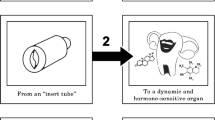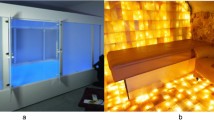Abstract
Objectives
We investigated the hypothesis that the vagina generates electric waves which effect vaginal contraction during penile thrusting.
Methods
In 24 healthy female volunteers, the electric waves of the vagina were recorded by two electrodes applied to its wall. The vaginal pressure was registered by a manometric tube. The electric waves and vaginal pressure were recorded at rest and on vaginal distension by condom in increments of 10 ml of carbon dioxide. The test was repeated after vaginal anesthetization proximally and distally to the electrodes.
Results
Slow waves (SWs) were recorded from the two electrodes with regular rhythm and similar frequency, amplitude and conduction velocity. They were randomly followed or superimposed by action potentials (APs). Vaginal pressure increase was coupled with APs. Large-volume condom distension significantly increased the electric waves’ variables and pressure. Upon vaginal anesthetization, the electric waves were recorded proximal but not distal to the anesthetized area.
Conclusions
Electric waves could be recorded from the vagina. They spread caudad. A pacemaker was postulated to exist at the upper vagina evoking these waves. The electric waves seem to be responsible for the vaginal contractile activity. Large-volume vaginal distension effected an increase in the vaginal electric waves and pressure which probably denotes increased vaginal muscle contraction. It appears that penile thrusting during coitus stimulates the vaginal pacemaker which effects an increase in vaginal electric activity and muscle contractility and thus leading to an increase in sexual arousal. The vaginal pacemaker seems to represent the G spot, which is claimed to be a small area of erotic sensitivity in the vagina. The electrovaginogram may act as a diagnostic tool in the investigation of sexual disorders.






Similar content being viewed by others
References
Abo M, Konot T, Lu CL et al (2000) Effects of caffeine on gastrointestinal myoelectric activity and colonic spike activity in dogs. Scand J Gastroenterol 33:368–374
Aube AC, Chewrbut C, Barbier M et al (1999) Altered myoelectric activity in noninflamed ileum of rats with colitis induced by trinitrobenzene sulphonic acid. Neurogastroenterol Motil 11:55–62
Ayad VJ, Gilbert CL, McGoff SA et al (1994) Actions of oxytocin and vasopressin on oestrogen-induced electromyographic activity recorded from the uterus and oviduct of anoestrous ewes. Reprod Fertil Dev 6:203–209
Bancroft J (1989) The biological basis of human sexuality. In: Bancroft J (ed) Human sexuality and its problems, 2nd edn. Churchill Livingstone, Edinburgh, p 38
Bancroft J (1989) The sexual arousal. In: Bancroft J (ed) Human sexuality and its problems, 2nd edn. Churchill Livingstone, Edinburgh, p 69
Bassotti G, Morelli A, Whitehead WE (1992) Abnormal rectosigmoid myoelectric response to eating in patients with severe idiopathic constipation (slow transit type). Dis Colon Rectum 35:753–756
Dapoigny M, Trolese JF, Bommerlae G et al (1988) Myoelectric spiking activity of right colon, left colon and rectosigmoid of healthy humans. Dig Dis Sci 33:1007–1012
Frexinos J, Bueno L, Fuiramonti J (1985) Diurnal changes in myoelectric spiking activity of the human colon. Gastroenterology 88:1104–1110
Garcia D, Hita G, Mompean B et al (1991) Colonic motility: electric and manometric description of mass movement. Dis Colon Rectum 34:577–584
Geldof H, Van der Schee EJ, Van Blankenstein M et al (1986) Electrogastrographic study of gastric myoelectrical activity in patients with unexplained nausea and vomiting. Gut 27:799–808
Gilbert CL, Cripps PJ, Wathes DC (1992) Effect of okytocin on the pattern of electromyographic activity in the oviduct and uterus of the ewe around oestrus. Reprod Fertil Dev 4:193–203
Grafenburg E (1950) The role of the urethra in female orgasm. Int J Sexol 111:145–148
Hoch Z (1980) The sensory arm of the female orgasmic reflex. J Sex Educ Ther 6:4–7
Hofmeister JF, Slocumb JC, Kottmann LM et al (1994) A noninvasive method for recording the electrical activity of the human uterus in vivo. Biomed Instrum Technol 28:391–404
Junqueira LC, Carneiro J, Long JA (1986) The female reproductive system. In: Janqueira LC Carneiro J, Long JA (eds) Basic histology, 5th edn. Large, Los Altos, p 485
Shafik A (1993) Electrorectogram in chronic proctitis. World J Surg 17:675–679
Shafik A (1993) Vaginocavernosus reflex. Clinical significance and role in sexual act. Gynecol Obstet Invest 35:114–117
Shafik A (1994) Study of the electrical and mechanical activity of the rectum. Experimental study. Eur Surg Res 26:87–93
Shafik A (1995) Electrorectography in chronic constipation. World J Surg 19:772–775
Shafik A (1995) Electrorectogram in the neuropathic rectum. Paraplegia 33:346–349
Shafik A (1995) Vagino-puborectalis reflex. The description of a new reflex and its clinical significance. Int J Gynecol Obstet 51:61–62
Shafik A (1996) Electrovesicogram in stress urinary incontinence. A preliminary study. Int Urogynecol J 7:203–207
Shafik A (1996) Study of the electromechanical activity of the uterus: experimental study. Clin Exp Obst Gynecol 23:73–78
Shafik A (1997) Electrohysterogram: study of the electromechanical activity of the uterus in humans. Eur J Obstet Gyn Reprod Biol 73:85–89
Acknowledgement
Margot Yehia assisted in preparing the manuscript.
Author information
Authors and Affiliations
Corresponding author
Rights and permissions
About this article
Cite this article
Shafik, A., El Sibai, O., Shafik, A.A. et al. The electrovaginogram: study of the vaginal electric activity and its role in the sexual act and disorders. Arch Gynecol Obstet 269, 282–286 (2004). https://doi.org/10.1007/s00404-003-0571-0
Received:
Accepted:
Published:
Issue Date:
DOI: https://doi.org/10.1007/s00404-003-0571-0




